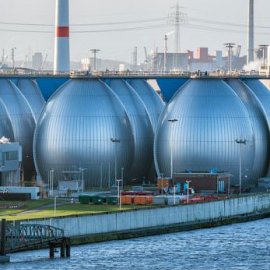Saltwater Engineering
-
English
-
ListenPause
[intro music] Welcome to World Ocean Radio… I’m Peter Neill, Director of the World Ocean Observatory. The ocean is this enormous volume of saltwater, and, while it covers a majority of the Earth’s surface, we often ignore it in favor of our more immediate need for fresh water to survive. This distinction misinforms many things: for example, in the world of policy and science, the separation of salt and fresh results in the fact that at the international meetings of the World Water Forum, a gathering of thousands of government and scientific leaders, presenting hundreds of learned papers on the topic of water, the ocean is almost never mentioned, much less focused on as an integral part of the global water cycle. The line of jurisdiction and interest is drawn at that ephemeral place where water becomes brackish or fresh, the so-called salt line below which is of little concern to the assembled expertise. It seems to me that this is bad science that can only result in bad policy, but I am no expert in these things. When we do think of salt water, we see it as a solution in which is suspended the marine food chain of species, large and small, that depend on that hospitable host fluid to thrive. We sometimes, but only recently, have begun to think of salt water as a possible source for fresh water supply, as unconventional irrigation for certain crops, and as a medium from which to extract heat geo-thermally as an alternative energy supply. But surely, such a vast resource must have other serious uses that could be of even greater benefit for the future. Let me describe a few. First, there is technology in development that will use the energy of the sun to turn salt water into fresh drinking water. Researchers at Rice University have engineered a portable device using nano-technology that combines membrane filtration with light-harvesting photonics to convert hot salt water, passing over a porous surface, to cold and enhancing the distillation process using less and freely available energy for application off the grid in coastal areas where the salt water is readily available. While the devices under test are small and portable, it would be possible to upscale the technology to serve larger areas, rural water systems and wastewater treatment, humanitarian emergency response in remote sites, and use for offshore facilities surrounded by the ocean. A second example is the use of saltwater for flushing of toilets and other effluent treatment, predictably questionable with regard to chlorine and other possible toxins that might adversely affect the marine habitat. But studies have suggested the opposite: that such a system might actually improve and protect marine ecosystems, in fact be less impactful than similar discharge of freshwater flushing only which upsets the normal conditions of localized habitats at treatment outlets. If such a technology could be applied safely, again at scale, think of the pressure drop on consumption of freshwater supplies already limited. A third example is the use of seawater for air-conditioning in urban areas and southern regions. The introduction of deep cold water from a lake or the ocean suggests a technology that takes advantage of available adjacent supply and is more economically and environmentally friendly by conserving freshwater and substantially reducing energy costs. Studies by Makai Ocean Engineering in Hawaii suggest that such a system reduces the cost of conventional air-conditioning by 90%; decreases reliance generally of fossil fuels thereby alleviating air pollution, acid rain, and global warming; has short-term economic payback and long-term savings; is independent of fluctuating energy prices; is available for alternative utilities like sanitation; and again relieves demand on dwindling freshwater supply. This technology is presently being used in six institutions with others in progress. And finally a fourth example: the use of saltwater flow over a specially patterned surface to generate electrical voltage – essentially the movement of ions over a charged surface, the friction of positives over negatives resulting in an electrical difference, again potentially scaled by the speed of flow, the area of surface, and the efficiency of collecting and aggregating the charge as energy. When I think of the areas of concrete in drainages, the faces of dams, and the frontage of sea walls and piers, I see an amazing secondary utility, that water generating the power to monitor those constructs, to run pumps, and to illuminate areas for safety, navigation, and other necessary economical uses. It’s all about invention. I would submit that we have not even begun to explore ocean systems, to invent adaptations and responses, and to derive heretofore unimagined advantage from the beneficent ocean. We will discuss these issues, and more, in future editions of World Ocean Radio. [outro music]
This week on World Ocean Radio host Peter Neill gets us thinking about seawater: as a resource for fresh drinking water, as a means for robust renewable energy, and perhaps so much more; and he discusses the potential for inventive ideas using ocean systems that have yet to be imagined or explored.
Do you prefer the written word? Head on over to Medium.com/@TheW2O.
About World Ocean Radio
World Ocean Radio is a weekly series of five-minute audio essays available for syndicated use at no cost by college and community radio stations worldwide. Peter Neill, Director of the World Ocean Observatory and host of World Ocean Radio, provides coverage of a broad spectrum of ocean issues from science and education to advocacy and exemplary projects.
Image
A desalination plant in Hamburg, Germany
Credit
World Atlas
- Login to post comments



